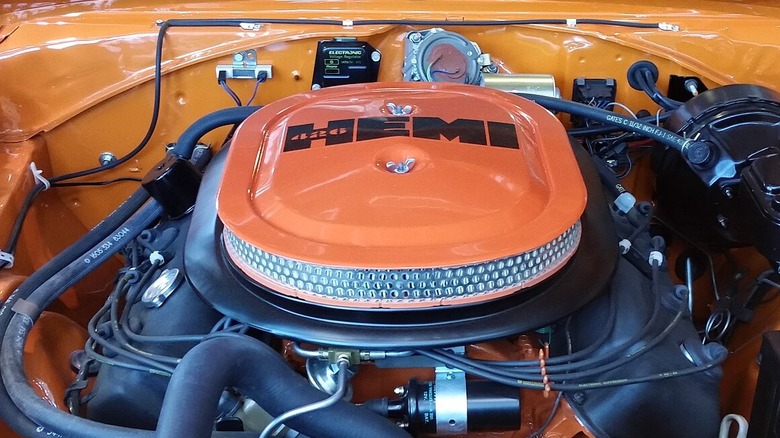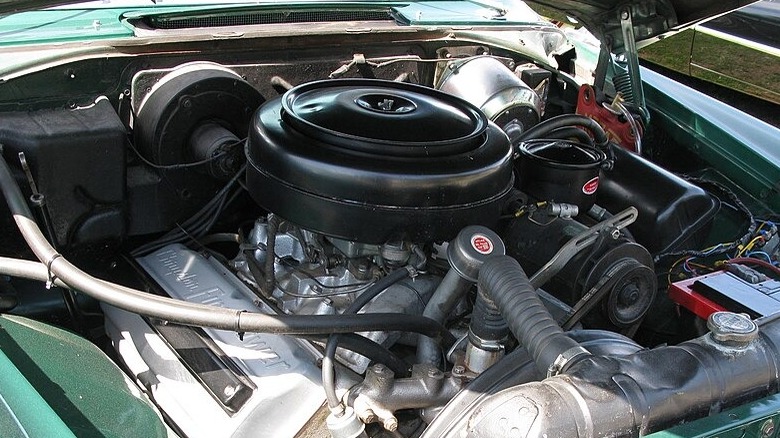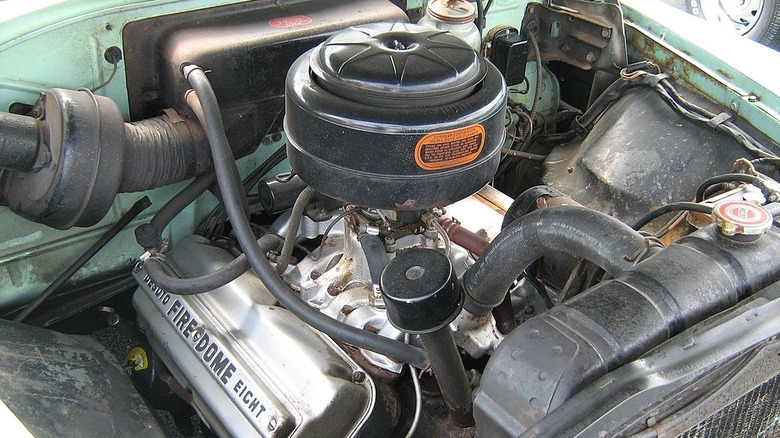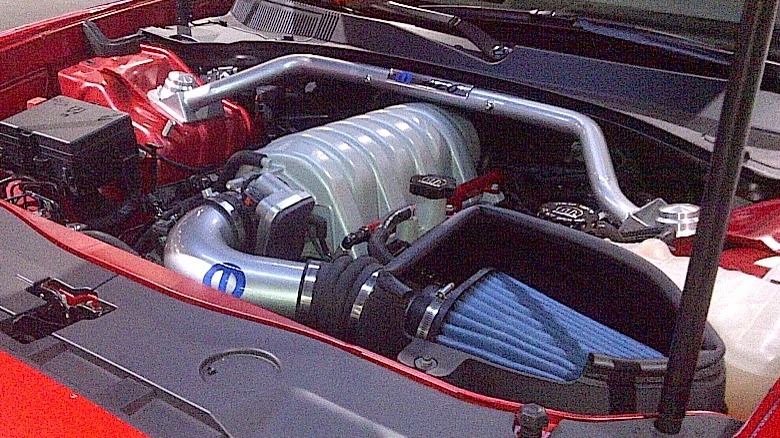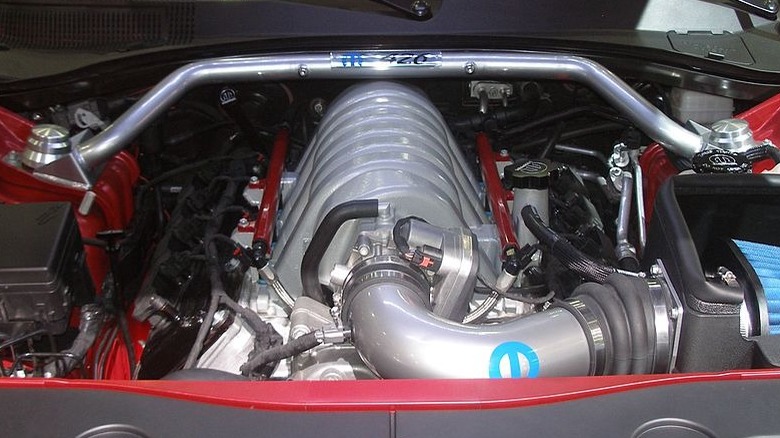What Size HEMI Engines Did Chrysler Make And Which Is The Biggest?
2024 is a sad year for many engine enthusiasts because it will see Dodge discontinue production of its famed Hemi engine. Car companies have long been trying to adhere to ever changing emissions restrictions for decades, and with the most recent ones, the large Hemi V8 engines simply do not cut it anymore, which is why the Stellantis Hurricane I6 engine will be the principal replacement for the Hemi going forward.
This isn't the first time production ended on the Hemi engine. Originally created by Chrysler for the 1951 Chrysler New Yorker, they were called FirePower engines, and these stopped being made in 1958. Chrysler revived the design six years later, giving it the Hemi name, but in 1971, they went away again. This means that this era of the Hemi is the third time they have been put out to pasture, so it's not inconceivable they'll return.
Throughout all of these different eras, Chrysler has made so many different Hemi V8 engines. These range from the surprisingly compact to the absolutely massive. It even produced one V6 in there too. If you are out there looking to get yourself a recent or classic Hemi engine for your vehicle, you have a great many options out there to choose from. Let's go through the history of the Hemi to showcase all of the various sizes they've been made in and see which one is the true hulking behemoth.
[Featured image by Steven Kevil via Wikimedia Commons | Cropped and scaled | CC BY-SA 4.0]
The FirePower engines
When the Chrysler Hemi engine was first introduced back in 1951, there was just one size. The original FirePower featured 331 cu. in. of displacement and could deliver 180 hp. At first, it was only available with a two-barrel carburetor, but in 1954, Chrysler revamped the 331 FirePower. Along with the two-barrel carburetor version, which could now generate 195 hp, a four-barrel carburetor option was also made available that had an output of 235 hp. One year later, that standard output increased to 250 hp thanks to an increase in compression ratio.
1955 would also be the end of the 331 FirePower. Demand was higher for larger displacement sizes, so 1956 saw Chrysler debut the 354 FirePower. This was essentially the same build as the 331, but by increasing the bore and compression ratio, Chrysler made a more powerful engine that could produce anywhere from 280 hp to 340 hp, depending on which vehicle it was in. While that's good, this engine ended up being just a one-year stopgap to an even bigger engine.
The final FirePower was once again made by increasing the bore of the one already in use, but this one also increased the stroke length as well for a grand total of 392 cu. in. of displacement. For the first year, the standard engine generated 325 hp, and thanks to another compression ratio increase, it was 345 hp the following year. Meanwhile the four-barrel carburetor version upped those numbers to 375 hp and 380 hp, respectively.
[Featured image by Herranderssvensson via Wikimedia Commons | Cropped and scaled | CC BY-SA 3.0]
The other 1950s Hemis
An important note about FirePower engines is that these are what the hemispherical engines were called when they were under the hood of Chrysler. That may have been the company that produced them, but they also appeared in cars of other companies as that were owned by Chrysler, namely DeSoto and Dodge. You might think that the that these three brands would simply share the same engines, but that is not the case. The Hemi engines for these two companies are actually far more varied than the ones in Chryslers themselves.
The second of these Hemi V8 engines was for the 1952 DeSoto FireDome, and it was quite a bit smaller than that first FirePower engine with just 276 cu. in. of displacement, which could generate 160 hp that was upped to 170 hp two years later. Much like the FirePower engines, it wouldn't be until 1955 that DeSoto started using a new Hemi, which was the larger 296 cu. in. model. However, the FireDome engines increased at a much more rapid pace, because by 1958, DeSoto would go on to use 330, 341, and 345 displacement sizes too.
Dodge gave the Hemi another name entirely: the Red Ram. These were the smallest Hemis of the bunch, starting off with a 241-cu. in. V8 in 1953. In a four-year stretch, Dodge also created 270, 315, and 325 displacement variations of the Red Ram. That means there were a dozen Hemis in the 1950s with no crossover among the brands.
[Featured image by CZmarlin via Wikimedia Commons | Cropped and scaled | Public Domain]
The modern crop of Hemi engines
Let's jump all the way to this most recent generation of the Hemi engine, where they actually just were called Hemi engines. Gone are the days of measuring engine displacement size with cubic inches, and now the company has transitioned over to liters. The smallest and most common Hemi V8 of this new era debuted at the launch in 2003 with a 5.7L model, which has been used in everything from the Dodge Charger to Ram pickup trucks. The cubic inch equivalent would be 345 cu. in., which is what the largest DeSoto FireDome was back in the day. Now, it is the smallest displacement size.
The next size up would be the 6.1L — or 370 cu. in. — Hemi. These were implemented in the higher performance SRT models of different Stellantis vehicles, like the aforementioned Charger or the Dodge Challenger — starting around 2006 and lasting until 2010. The 6.1L Hemi wouldn't see a true replacement until the slightly larger, supercharged 6.2L Hemi in the mid-2010s. This particular Hemi would be given the name the Hellcat, and a variation was introduced in 2018 called the Demon with an even more powerful supercharger.
The next step up from this is the 6.4L Hemi V8. This began life as a crate engine and found its way into production vehicles in the early 2010s. This engine would match the size of the largest 392 FirePower engine, but neither of them is the biggest a Hemi has ever gotten.
[Featured image by artistmac via Wikimedia Commons | Cropped and scaled | CC BY-SA 2.0]
The 426 and the Hellephant
You may have noticed that the second generation of the Hemi wasn't gotten a mention yet. That is because the second-generation Hemi was the largest Hemi created — the 426 Hemi V8. In today's measuring system, that would be a 7.0L engine. This particular engine has become one of the hallmarks of the heyday of the muscle car and was used in so many different cars from its creation in 1964 to its end in 1971. However, the legacy of the 426 Hemi does not end there.
In 2012, Dodge unveiled the Dodge Charger Redline, and after 40 years of the 426 Hemi being out of commission, a new version of that engine was placed underneath the hood of this new variant, giving the car a whopping 590 hp. This enjoyed a nice two-year run in the Redline before being put back on the shelf. It didn't stay on that shelf long though, as a revamped 426 Hemi was unveiled. This crate engine was given the nickname the Hellephant, taking a page from the 6.2L Hellcat, and if you though that 590 hp was a lot of power, that pales in comparison to what this one can do. The Hellephant can generate 1,000 hp and 950 lb.-ft. of torque. If the Hemi engine line never makes another return, it was able to go out with its biggest and most powerful engine of the bunch.
[Featured image by Oilpanhands via Wikimedia Commons | Cropped and scaled | CC BY-SA 3.0]
